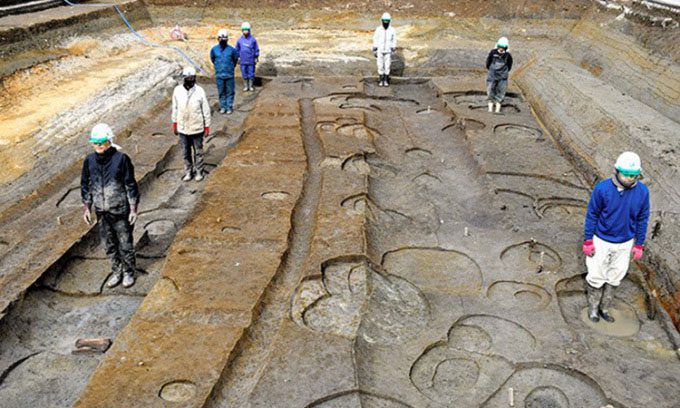The structure believed to be the residence of Prince Toneri covers an area of 370m2, consisting of three main buildings and built using the hottate-bashira architectural method.
Japanese archaeologists have uncovered evidence suggesting that a relic in Heijo-kyo, Nara Prefecture, may be the residence of Prince Toneri (676-735), one of the sons of Emperor Tenmu, reported Ashahi Shimbun on April 5. Prince Toneri is renowned for compiling the “Nihon Shoki” (Chronicles of Japan).

Researchers standing at the site of the giant wooden pillars that were buried to visualize the scale of Prince Toneri’s residence in Nara. (Photo: Nara City Education Board)
This site dates back to the Nara Period (710-784) and was expected to be developed into a residential complex. However, excavations conducted from January to March revealed remnants of an ancient structure built using the hottate-bashira architectural method, where large wooden pillars were buried underground to support a gigantic structure.
The Nara City Education Board stated that the newly discovered site covers approximately 370m2 and appears to consist of three main buildings arranged in a north-south orientation. The northernmost building is the largest, measuring about 20m in the east-west direction and over 10m in the north-south direction. The square holes excavated for the pillars are also quite large, each measuring 1.5m on each side.
Heijo-kyo, the capital of Japan during the Nara period, was constructed in a grid pattern. The basic land unit was the town—a square area measuring 130m on each side. Royals, nobles, and officials were allocated plots of land, with sizes determined by rank. Nobles ranked 5 or lower received one town, while those in higher positions, such as Prince Nagaya (circa 676-729), received four towns.
The excavation area is considered an ideal location for the residences of the nobility. The newly discovered structure spans several towns, according to scientists. They also found roof tiles from the same kiln scattered across an area equivalent to four towns.
Toshihide Omi, a senior expert on cultural properties at the Agency for Cultural Affairs of Japan, believes that Prince Toneri may have had a grand residence in the capital’s center. These new findings support this hypothesis. “Some of the buildings were fenced off. This sign indicates that this was likely a noble’s residence rather than a government building,” he stated.





















































